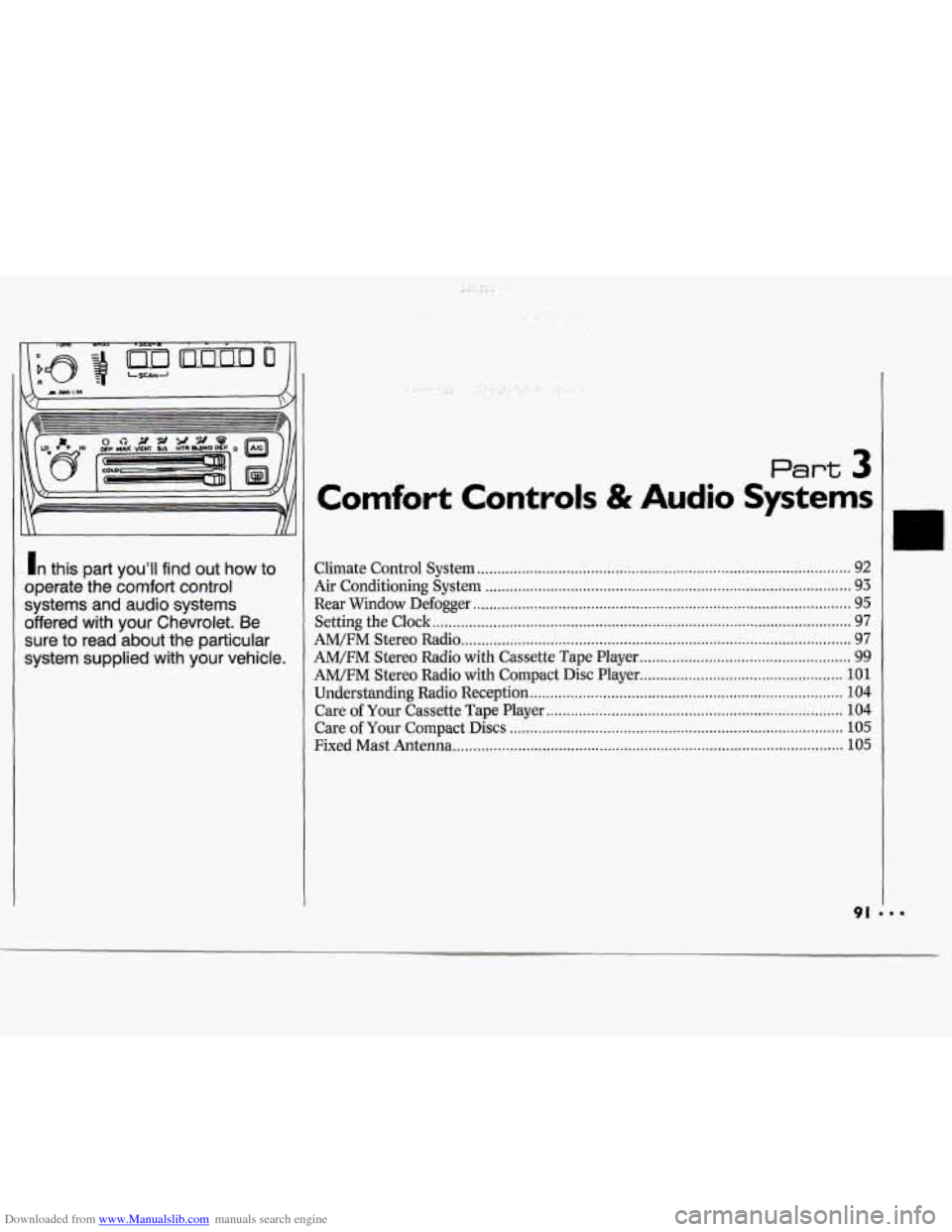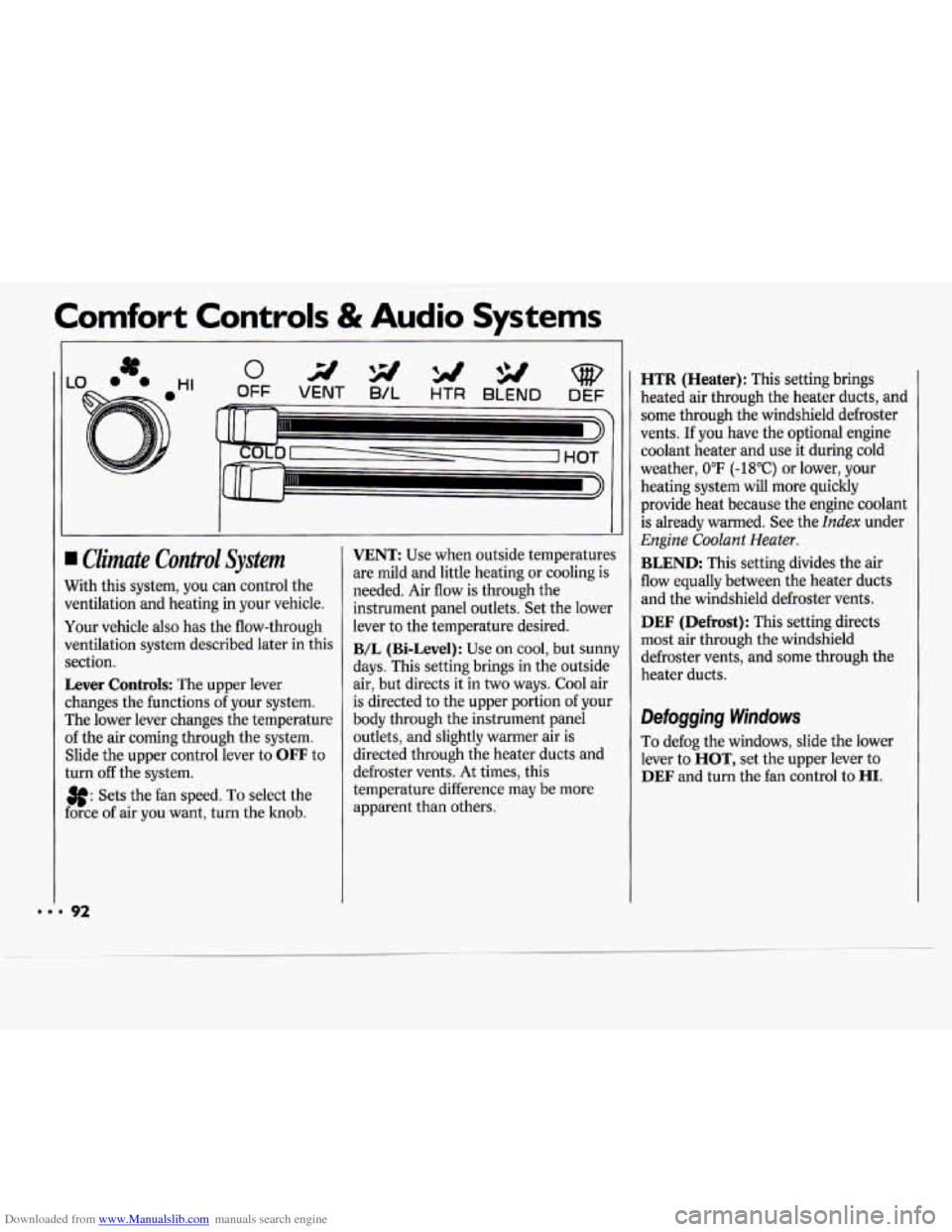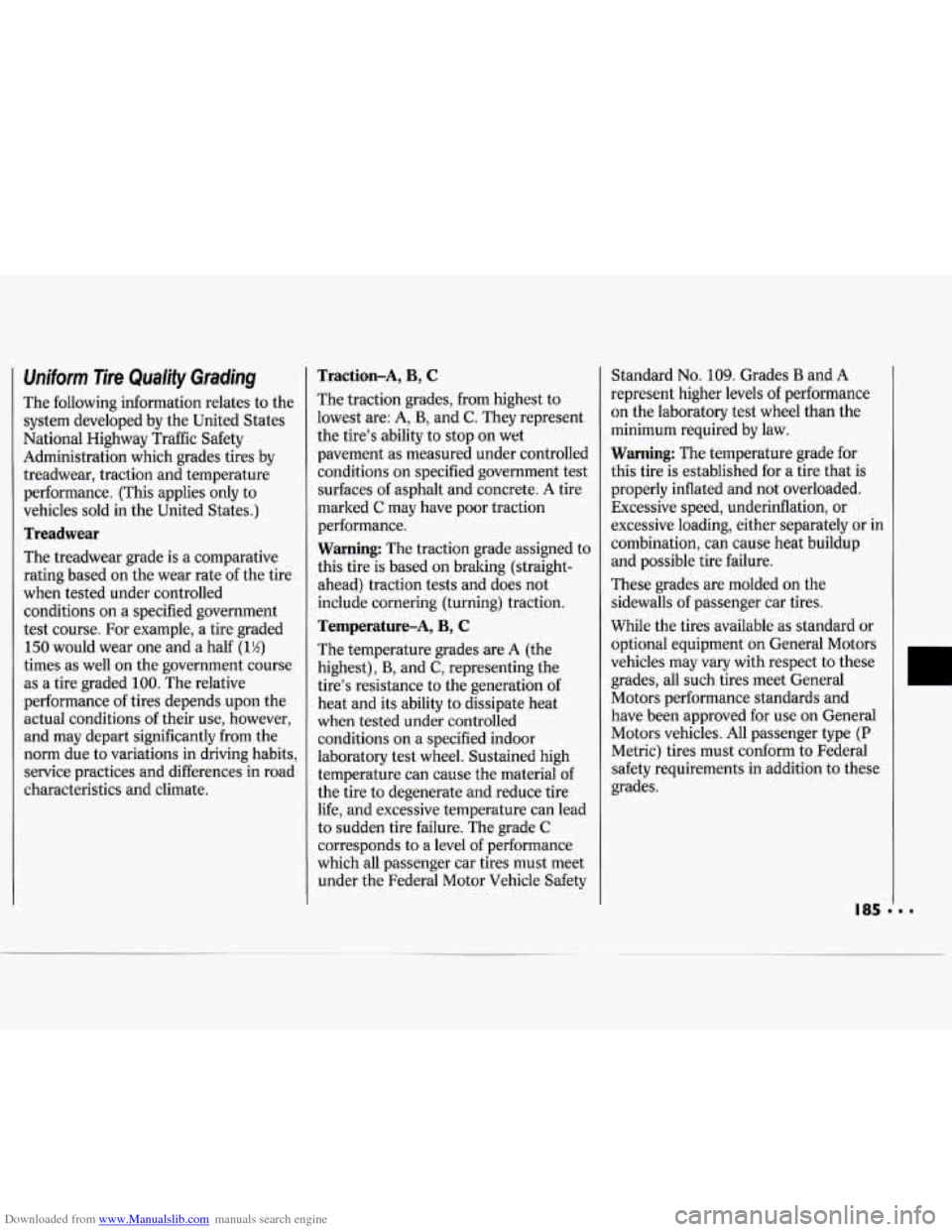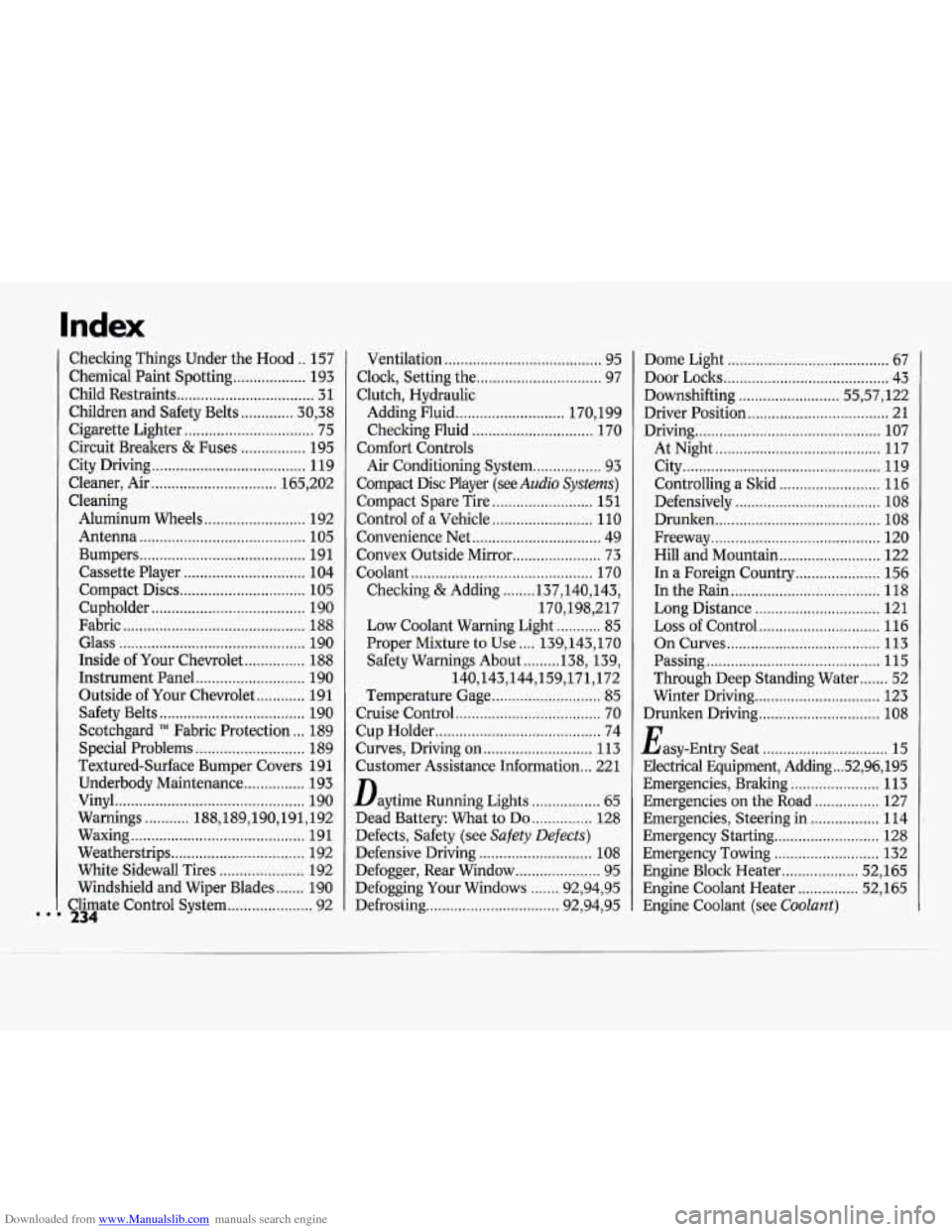1994 CHEVROLET CAVALIER climate control
[x] Cancel search: climate controlPage 82 of 243

Downloaded from www.Manualslib.com manuals search engine The Instrument Panel-
Your Information System
Your instrument panel is designed to let
you know at a glance how your vehicle
is running. You’ll
know how fast you’re
going, how much fuel you’re using, and
many other things you’ll need to drive
safely and economically. The
main components of your
instrument panel are:
1. Side Vent
2. Instrument Panel Intensity Control
3. Turn Signal/Multifunction Lever
4. Hazard Warning Flashers Switch
5. Instrument Cluster
6. Ignition Switch
7. Windshield Wipermasher Controls
8. Interior Light Control
9. Audio System
10. Center Vents
1 1. Cup Holder
12. Side Vent
13. Glove Box
14. Climate Controls and Rear Window
15. Parking Brake Lever
16. Ashtray/Lighter
17. Gearshift Lever
18. Horn
19. Tilt Steering Wheel Lever (Option)
20. Fuse Panel
21. Hood Release Lever
Defogger
Page 92 of 243

Downloaded from www.Manualslib.com manuals search engine In this part you'll find out how to
operate the comfort control systems and audio systems
offered with your Chevrolet. Be
sure to read about the particular
system supplied with your vehicle.
Part 3
Comfort Controls & Audio Systems
Climate Control System ........................................................................\
.................... 92
Air Conditioning System ........................................................................\
.................. 93
Rear Window Defogger ........................................................................\
..................... 95
Setting the Clock ........................................................................\
............................... 97
AM/FM Stereo Radio ........................................................................\
........................ 97
AM/FM Stereo Radio with Cassette Tape Player .................................................... 99
AM/FM Stereo Radio with Compact Disc Player.. ................................................ 101
Understanding Radio Reception. ........................................................................\
.... 104
Care of Your Cassette Tape Player ........................................................................\
. 104
Care of Your Compact Discs ........................................................................\
.......... 105
Fixed Mast Antenna ........................................................................\
........................ 105
Page 93 of 243

Downloaded from www.Manualslib.com manuals search engine Comfort Controls & Audio Systems
I Climate Control System
Nith this system, you can control the
rentilation and heating in your vehicle.
four vehicle also has the flow-through
Jentilation system described later in this
rection.
Lever Controls: The upper lever
:hanges the functions
of your system.
rhe lower lever changes the temperature
If the air coming through the system.
Slide the upper control lever to
OFF to
:urn
off the system.
3f: Sets the fan speed. To select the
:orce of air you want, turn the knob.
VENT: Use when outside temperatures
are mild and little heating or cooling is
needed. Air flow is through the
instrument panel outlets. Set the lower
lever to the temperature desired.
B/L (Bi-Level): Use on cool, but sunny
days. This setting brings in the outside
air, but directs it in two ways. Cool air
is directed to the upper portion of your
body through the instrument panel
outlets, and slightly warmer air is
directed through the heater ducts and
defroster vents.
At times, this
temperature difference may be more
apparent than others.
HTR (Heater): This setting brings
heated air through the heater ducts, and
some through the windshield defroster
vents.
If you have the optional engine
coolant heater and use it during cold
weather,
0°F (-18°C) or lower, your
heating system will more quickly
provide heat because the engine coolant
is already warmed. See the
Index under
Engine Coolant Heater.
BLEND: This setting divides the air
flow equally between the heater duets
and the windshield defroster vents.
DEF (Defrost): This setting directs
most air through the windshield
defroster vents, and some through the
heater ducts.
Defogging Windows
To defog the windows, slide the lower
lever to
HOT, set the upper lever to
DEF and turn the fan control to HI.
Page 186 of 243

Downloaded from www.Manualslib.com manuals search engine Uniform Tire Qualify Grading
The following information relates to the
system developed by the United States
National Highway Traffic Safety
Administration which grades tires by
treadwear, traction and temperature
performance. (This applies only to
vehicles sold in the United States.)
Treadwear
The treadwear grade is a comparative
rating based on the wear rate
of the tire
when tested under controlled
conditions on a specified government
test course. For example, a tire graded
150 would wear one and a half (1 Yz)
times as well on the government course
as a tire graded
100. The relative
performance of tires depends upon the
actual conditions
of their use, however,
and may depart significantly from the
norm due to variations in driving habits,
service practices and differences in road
characteristics and climate.
Traction-A, B, C
The traction grades, from highest to
lowest are: A,
B, and C. They represent
the tire’s ability to stop on wet
pavement as measured under controlled
conditions on specified government test
surfaces
of asphalt and concrete. A tire
marked
C may have poor traction
performance.
Warning: The traction grade assigned to
this tire
is based on braking (straight-
ahead) traction tests and does not
include cornering (turning) traction.
Temperature-A, B, C
The temperature grades are A (the
highest),
B, and C, representing the
tire’s resistance to the generation
of
heat and its ability to dissipate heat
when tested under controlled conditions on a specified indoor
laboratory test wheel. Sustained high
temperature can cause the material of
the tire to degenerate and reduce tire
life, and excessive temperature can lead
to sudden tire failure. The grade
C
corresponds to a level of performance
which all passenger car tires must meet
under the Federal Motor Vehicle Safety Standard
No.
109. Grades B and A
represent higher levels
of performance
on the laboratory test wheel than the
minimum required by law.
Warning: The temperature grade for
this tire is established for a tire that is
properly inflated and not overloaded.
Excessive speed, underinflation, or
excessive loading, either separately or in
combination, can cause heat buildup
and possible tire failure.
These grades are molded on the
sidewalls of passenger car tires.
While the tires available as standard or
optional equipment
on General Motors
vehicles may vary with respect to these
grades, all such tires meet General
Motors performance standards and
have been approved for use on General
Motors vehicles. All passenger type
(P
Metric) tires must conform to Federal
safety requirements in addition to these
grades.
1
Page 235 of 243

Downloaded from www.Manualslib.com manuals search engine Checking Things Under the Hood .. 157
Child Restraints
.................................. 31
Children and Safety Belts ............. 30. 38
Cigarette Lighter
................................ 75
Circuit Breakers
& Fuses ................ 195
City Driving.,
.................................... 119
Cleaner. Air ............................... 165. 202
Cleaning Chemical
Paint Spotting
.................. 193
Aluminum Wheels
......................... 192
Antenna
......................................... 105
Bumpers
......................................... 191
Cassette Player .............................. 104
Compact Discs
............................... 105
Cupholder
...................................... 190
Fabric
............................................. 188
Glass .............................................. 190
Inside of Your Chevrolet
............... 188
Instrument Panel ........................... 190
Outside of Your Chevrolet
............ 191
Safety Belts
.................................... 190
Scotchgard
TM Fabric Protection ... 189
Textured-Surface Bumper Covers 191
Underbody Maintenance
............... 193
Vinyl
............................................... 190
Warnings
........... 188,189,190,191, 192
Waxing
........................................... 191
Weatherstrips
................................. 192
White Sidewall Tires
..................... 192
Windshield and Wiper Blades
....... 190
Climate Control System
..................... 92
Special Problems
........................... 189
234
Ventilation ....................................... 95
Clock. Setting the
............................... 97
Clutch, Hydraulic Adding Fluid
........................... 170, 199
Checking Fluid
.............................. 170
Comfort Controls
Compact Disc Player (see
Audio Systems)
Compact Spare Tire ......................... 151
Control of
a Vehicle ......................... 110
Convenience Net
................................ 49
Convex Outside Mirror
...................... 73
Coolant
............................................. 170
Checking
& Adding ........ 137,140,143,
170,198, 217
Low Coolant Warning Light ........... 85
Proper Mixture to Use .... 139,143, 170
140,143,144,159,171, 172
Temperature Gage
........................... 85
Cruise Control .................................... 70
Cup Holder
......................................... 74
Customer Assistance Information
... 22 1
Daytime Running Lights ................. 65
Dead Battery: What to Do ............... 128
Defects, Safety (see
Safety Defects)
Defensive Driving ............................ 108
Air Conditioning System
................. 93
Safety Warnings About
......... 138, 139,
Curves, Driving on
........................... 113
Defogger, Rear Window ..................... 95
Defogging Your Windows
...... .92,94, 95
Defrosting
................................. 92,94, 95 Dome Light
........................................ 67
Door Locks
......................................... 43
Downshifting
......................... 55.57. 122
Driver Position
................................... 21
Drnmg 107
At Night
......................................... 117
City
................................................. 119
Controlling a Slid
......................... 116
Defensively
.................................... 108
Drunken
......................................... 108
Freeway
.......................................... 120
Hill and Mountain
......................... 122
In a Foreign Country
..................... 156
In the Rain
..................................... 118
Long Distance ............................... 121
Loss of Control
.............................. 116
On Curves ...................................... 113
Passing ........................................... 115
Through Deep Standing Water ....... 52
Winter Driving
............................... 123
.. ..............................................
..............................
E
Drunken Driving 108
asy-Entry Seat
............................... 15
Electrical Equipment, Adding ... 52,96, 195
Emergencies, Braking
...................... 113
Emergencies on the Road ................ 127
Emergencies, Steering in
................. 114
Emergency Starting
.......................... 128
Emergency Towing
.......................... 132
Engine Block Heater
................... 52, 165
Engine Coolant Heater
............... 52, 165
Engine Coolant (see
Coolant)